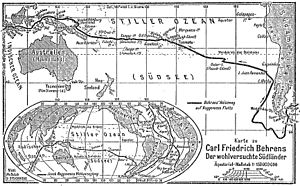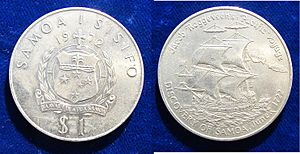Jacob Roggeveen facts for kids
Quick facts for kids
Jacob Roggeveen
|
|
|---|---|
| Born | 1 February 1659 |
| Died | 31 January 1729 (aged 69) |
| Nationality | Dutch |
| Other names | Roggewein, Commodore |
| Education | University of Harderwijk |
| Employer | Dutch West India Company |
| Spouse(s) | Marija Margaerita Vincentius, Anna Adriana Clement |
| Parent(s) | Arend Roggeveen, Maria Storm |
Jacob Roggeveen (born February 1, 1659 – died January 31, 1729) was a Dutch explorer. He is best known for discovering Easter Island on Easter Sunday in 1722. His journey was originally meant to find a large southern continent called Terra Australis. During his travels, he also found other islands like Bora Bora, Maupiti (both in the Society Islands), and islands in Samoa. Jacob planned this big trip with his brother, Jan Roggeveen, who stayed in the Netherlands.
Contents
Early Life and Career
Jacob Roggeveen's father, Arend Roggeveen, was a mathematician. He knew a lot about astronomy, geography, and how to navigate ships. His father was very interested in the idea of a huge, unknown southern land called Terra Australis. He even got permission to explore it, but it was Jacob who eventually led the expedition.
Jacob first worked as a notary in Middelburg, the main city of Zeeland, where he was born. In 1690, he earned a law degree from the University of Harderwijk. He later worked for the Dutch East India Company (VOC) from 1707 to 1714. He served as a "Council Lord of Justice" in Batavia, Dutch East Indies (which is now Jakarta). After his time there, he returned to Middelburg in 1714.
Exploring the Pacific Ocean
On August 1, 1721, Jacob Roggeveen began his famous expedition. This trip was supported by the Dutch West India Company, which was a rival to the Dutch East India Company. His main goals were to find the mysterious southern continent, Terra Australis, and to discover a new trade route to the "Spice Islands" by sailing west.
Roggeveen's fleet had three ships: the Arend, the Thienhoven, and the Afrikaansche Galey. There were 223 crew members on board.
The Journey Begins
The expedition first sailed south to the Falkland Islands, which Roggeveen renamed "Belgia Australis." They then passed through the Strait of Le Maire and continued even further south, beyond 60 degrees south latitude, before entering the vast Pacific Ocean.
Roggeveen's ships made their first landfall near Valdivia, Chile. They also visited the Juan Fernández Islands, staying there for about three weeks in early 1722.
Discovering Easter Island
The most famous moment of the journey happened on Easter Sunday, April 5, 1722. On this day, Roggeveen and his crew arrived at a remote island, which he named Easter Island (also known as Rapa Nui). He reported seeing between 2,000 and 3,000 people living there.
Further Discoveries and Challenges
As they continued their voyage, Roggeveen mapped the locations of several other islands. He charted six islands in the Tuamotu Archipelago, two islands in the Society Islands, and four islands in Samoa.
However, the expedition faced difficulties. Roggeveen's flagship, the Afrikaansche Galey, was lost at the Takapoto atoll. At another island called Makatea, there was a conflict with the local people, which resulted in some crew members being lost.
The two remaining ships sailed past New Guinea and eventually reached Batavia, Dutch East Indies in 1722. There, Roggeveen was arrested because he had sailed into an area where the Dutch East India Company had a special trading right, or monopoly. His ships were taken away. After a long legal case back in the Netherlands, the Dutch East India Company was ordered to pay Roggeveen for his losses and to pay his crew.
Images for kids
See also
 In Spanish: Jakob Roggeveen para niños
In Spanish: Jakob Roggeveen para niños




